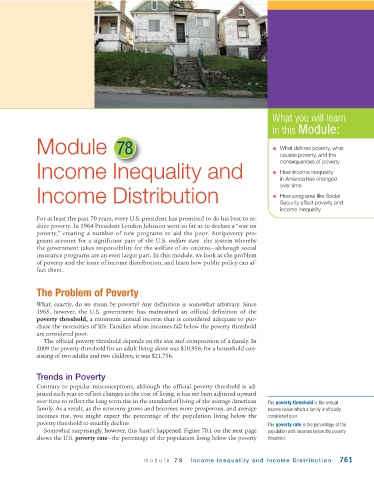Page 803 - Krugmans Economics for AP Text Book_Neat
P. 803
What you will learn
in this Module:
Module 78 • What defines poverty, what
causes poverty, and the
consequences of poverty
Income Inequality and • How income inequality
in America has changed
over time
Income Distribution • How programs like Social
Security affect poverty and
income inequality
For at least the past 70 years, every U.S. president has promised to do his best to re-
duce poverty. In 1964 President Lyndon Johnson went so far as to declare a “war on
poverty,” creating a number of new programs to aid the poor. Antipoverty pro-
grams account for a significant part of the U.S. welfare state—the system whereby
the government takes responsibility for the welfare of its citizens—although social
insurance programs are an even larger part. In this module, we look at the problem
of poverty and the issue of income distribution, and learn how public policy can af-
fect them.
The Problem of Poverty
What, exactly, do we mean by poverty? Any definition is somewhat arbitrary. Since
1965, however, the U.S. government has maintained an official definition of the
poverty threshold, a minimum annual income that is considered adequate to pur-
chase the necessities of life. Families whose incomes fall below the poverty threshold
are considered poor.
The official poverty threshold depends on the size and composition of a family. In
2009 the poverty threshold for an adult living alone was $10,956; for a household con-
sisting of two adults and two children, it was $21,756.
Trends in Poverty
Contrary to popular misconceptions, although the official poverty threshold is ad-
justed each year to reflect changes in the cost of living, it has not been adjusted upward
over time to reflect the long-term rise in the standard of living of the average American The poverty threshold is the annual
family. As a result, as the economy grows and becomes more prosperous, and average income below which a family is officially
incomes rise, you might expect the percentage of the population living below the considered poor.
poverty threshold to steadily decline. The poverty rate is the percentage of the
Somewhat surprisingly, however, this hasn’t happened. Figure 78.1 on the next page population with incomes below the poverty
shows the U.S. poverty rate—the percentage of the population living below the poverty threshold.
module 78 Income Inequality and Income Distribution 761

